Black holes: the inside story...
What's dark and so massive that not even light can escape its clutches? The answer is one of the most enigmatic phenomena known to physics: the black hole. And this week we explore the workings of these mysterious entities from how they distort time and what what would happen if you fell into one, to why black holes power the brightest lights in the Universe and how scientists are trying to image their interior. Plus, news of a dissolving brain implant, how ultrasound might be making some people sick, and why a real-life spider-man would have to be really, really small...
In this episode

00:51 - Public health fears for ultrasound
Public health fears for ultrasound
with Professor Timothy Leighton, University of Southampton
Ultrasound is any noise with a pitch higher than 20 kiloHertz - that's 20,000 waves per second. These sounds are beyond the normal hearing range of humans,  but despite being silent, exposure to it has been linked to symptoms such as nausea, headaches and fatigue in a small percentage of people. And now a review published this week is calling for measures to limit people's exposure to the sounds. According to the report, current safety guidelines are outdated, inappropriate and based on poor statistics. After receiving several letters from people claiming ultrasound was affecting them, the review's author, Southampton University's Timothy Leighton, decided to do some detective work, as he explained to Georgia Mills...
but despite being silent, exposure to it has been linked to symptoms such as nausea, headaches and fatigue in a small percentage of people. And now a review published this week is calling for measures to limit people's exposure to the sounds. According to the report, current safety guidelines are outdated, inappropriate and based on poor statistics. After receiving several letters from people claiming ultrasound was affecting them, the review's author, Southampton University's Timothy Leighton, decided to do some detective work, as he explained to Georgia Mills...
Timothy - First of all, I went out with a little team of volunteers and we looked to see what ultrasound was out there and, to be honest, we were quite astounded because there are the devices that produce moderate levels of ultrasound, like some of these automatic door opening systems, which open when someone breaks the ultrasonic beam as they walk towards them and some which produce quite intense ones. One, for example, was coming from the loudspeakers in the public address system in a rail station, which has a footfall of 3 million people, and there we found the reason for this is because, under EU legislation, the operators of these loudspeakers have to, at all times, know that they're working in case they need to evacuate the building, saying 'fire alert, fire alert' or whatever. To do that, they can't obviously say, testing, testing, one, two three all the time - that would annoy people - so, they send an ultrasonic signal between these loudspeakers in the belief that no-one can hear it and no-one will be perturbed, but these people were being perturbed. So I said to myself, okay, I'm going to try and look at the guidelines that protect these people and, you know, there must be levels that control what we put out, and found problems in those guidelines.
Georgia - What problems would you say these guidelines had?
Timothy - There's a lot of guidelines - a dozen or more - and they all seem to agree, roughly but when I looked into it they weren't agreeing, they were copying each other. Each time a new country, or an organisation needed new guidelines, it just saw what was out there and copied it and that gave the impression of consensus. And if you actually traced it back to the original evidence these guidelines were based on, you found a number of worrying things. They were based really on about six studies in the 1960s and 70s and they were primarily looking at the scenario where a man would be operating an ultrasonic cleaning bath at work, and the guidelines would be based on a man in the occupational setting who could then put on earphones, or be moved to another job, or be protected in some way from the source because he knows he's been exposed. And I say man because these studies were, primarily, using tests on adult males. Now we know that people lose their sensitivity to high frequencies as they get older and, in fact, many of these males worked in industry or had worked in the services and had operated firearms so, really, they were a bad set of people to test in order to produce guidelines to protect the public. You might have a grandmother who can't hear a high frequency holding in her arms a baby who can, not knowing why this child is perturbed. It's unreasonable to think they would wear hearing protection to protect themselves; we don't know how many hours per day they would be exposed and so the guidelines seem to be based on poor statistics, and wholly inappropriate for protecting the public to the kind of exposures we see them being exposed to today.
Georgia - But if ultrasound is, for the most part, beyond human hearing, how could it be causing symptoms of nausea, fatigue, and headaches? Well, Tim has a rather neat theory; when you're exposed to ultrasound your eardrum vibrates but the signal is not converted into a sound. However, other receptors do send your brain the message that, indeed, your eardrum is moving and this discrepancy between signals could confuse your brain, much in the same way as seasickness does.
Timothy - And what symptoms do we get from seasickness: headache, nausea, dizziness, fatigue - exactly the same set of symptoms. So, I'm not saying that ultrasound is causing seasickness; I think it's way to early days to look at that but I would like to put that on the table as something knock down so that we can get off the ground some sort of attitude to people who come claiming to have ill-effects from ultrasound that doesn't immediately dismiss them.
Georgia - If you fancy trying your hat at some detective work, Tim has released an app for smartphones, which can detect ultrasound, and it turns out it might be used in some unexpected places.
Timothy - There are strange and bizarre claims by companies of things that they will do with ultrasound. There was a company in the States that said it was developing a system whereby instead of plugging your mobile phone into the wall to charge it, you just hold it up in the air and it will beam ultrasound at it to charge it. There is even companies that claim to embed into adverts and websites, a code - a beep, beep, beep - at ultrasonic levels so, if you think you're in an anonymous environment like a hotel or an internet cafe, what they claim to be able to do for a fee is to embed an ultrasonic code into the adverts and your phone picks that up - a beep, beep, beep - without you knowing. Your phone has software on it you don't know about that identifies you and the thing you're watching, and then sends a signal back to inform the company of what you were doing. That's another area in which we, as people, are expanding into using ultrasound without the public knowing and, if we're exposing the public to such radiations, we need to get our public health framework accurate for that.

06:44 - Dissolving brain implant
Dissolving brain implant
with Professor John Rogers, University of Illinois
A dissolving brain implant, which could revolutionise the monitoring of traumatic 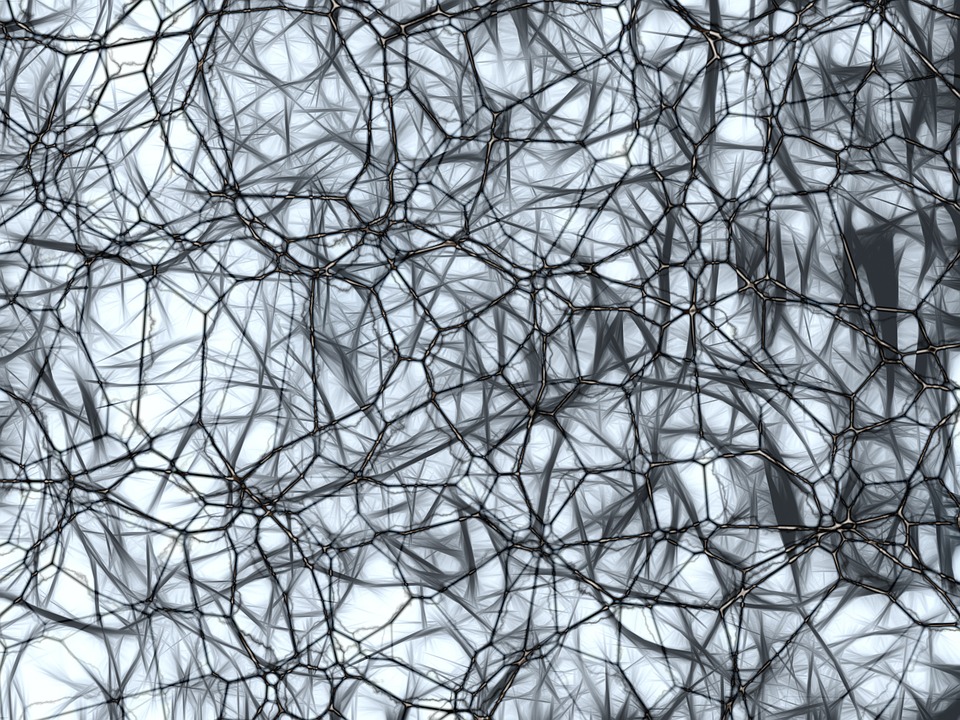 brain injuries, has been announced this week. In recent years we've seen increasing use of small, implanted electronic devices designed to monitor signs and symptoms in patients, or deliver drugs. But these implants often need to be removed surgically when they're no longer needed. Now US scientist John Rogers, from the University of Illinois, has come up with a "soluble" alternative, as he explains to Kat Arney...
brain injuries, has been announced this week. In recent years we've seen increasing use of small, implanted electronic devices designed to monitor signs and symptoms in patients, or deliver drugs. But these implants often need to be removed surgically when they're no longer needed. Now US scientist John Rogers, from the University of Illinois, has come up with a "soluble" alternative, as he explains to Kat Arney...
John - The particular device that we've reported in this current publication is designed to meet a current clinical need in the treatment of patients who suffer from severe traumatic brain injury and, in particular, to monitor their recovery process. So, it goes into the intracranial space to measure pressure and temperature because those two parameters are very important for a physician to track because, if they fall outside an error window, it could have profound negative consequences for the patient.
Kat - So you've basically built this tiny, wireless implant that goes in someone's brain. Does it completely vanish again when it's not needed?
John - Yes, completely goes away, entirely. You know, how do you do this? And it's a multi-material system, each one of which individually is soluble in biofluids to biocompatible end products. So magnesium, for example, is biocompatible; magnesium peroxide is a result of the dissolution of magnesium in biofluids; magnesium is part of a recommended daily diet - you find it in multivitamins, so we go through the list and we've been able to identify a full compliment of materials needed to do this. The clinical relevance, in terms of function, is during that critical recovery period when the patient is at highest risk for high pressure or high temperature. So the front end of that is about a week, so we've designed our devices to operate stably and reliably over that timeframe and then slowly degrade on a less critical timeframe that's typically two to three months.
Kat - Although this is a device that does dissolve so you don't have to take it out again, presumably you have to get it in. How do you get it into patients in the first place?
John - Well that's a good question. I mean the utility of these kind of intracranial monitors, even the non-resorbable ones that are used today, are typically most important in pretty severe traumatic brain injury cases. We're not talking about people that come into the hospital and have bumped their head. These are traumatic events and, in most cases, the sensors can be inserted at the tailend of a surgical procedure that needs to happen any way so the intracranial space is open for that purpose, and the device is just slipped in at the final step at that intervention. If the skull is not opened in that context then what people do today is they create small burr holes through the skull and inset the device, so their miniaturization becomes an important aspect of the device design because you want to minimise the impact on the patient getting it in. So, in that sense, the physics of the way that our devices work are compatible with downscaling, even to a further degree than we've demonstrated in this paper. The device is about the size of a grain of rice but they could be much smaller.
Kat - Could this kind of technology be used for anything else, not just monitoring signs and symptoms in patients?
John - Yes, I think there are a lot of other functions that could be interesting, for example, going beyond just sensing and monitoring to stimulation and intervention. So we have parallel work, as an example, resorbable devices that do electrical stimulation of the peripheral nervous system and, if you look at the healing of peripheral nerves, there's data in the literature that if you stimulate electrically that damaged site, in an appropriate way, you can actually, significantly accelerate the healing process. And then once the nerve is healed and you don't need the device any more, so you'd just engineer it to just dissolve away.
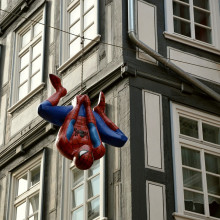
11:11 - Why Spider-Man would fall off buildings
Why Spider-Man would fall off buildings
with Dr David Labonte, University of Cambridge
Have you ever dreamt of climbing up the outside of a building like Spiderman? 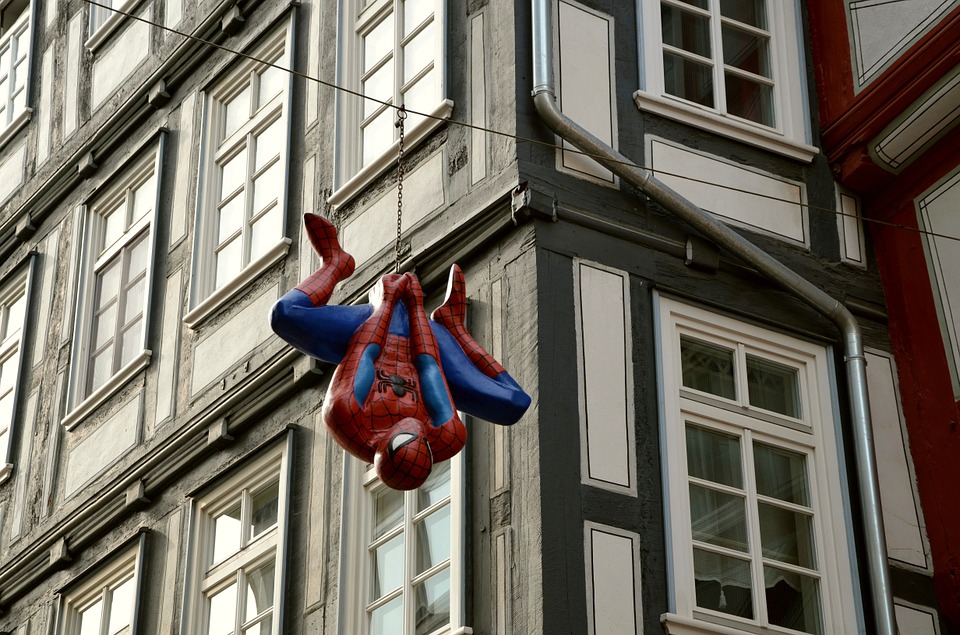 Making that dream a reality would require specially adapted adhesive feet that can take advantage of weak molecular forces of attraction between your body surface and the wall, much like a gecko. Felicity Bedford spoke to David Labonte from Cambridge University who has been investigating whether there's a good reason that this wouldn't work for humans...
Making that dream a reality would require specially adapted adhesive feet that can take advantage of weak molecular forces of attraction between your body surface and the wall, much like a gecko. Felicity Bedford spoke to David Labonte from Cambridge University who has been investigating whether there's a good reason that this wouldn't work for humans...
David - There's only a certain range in sizes that actually use a sticky pad. So you find you find tiny mites, you find big geckos, you find frogs and spiders and many different insects in between, and the question that we were interested in is whether there's actually a limit, or what is the limit to the size you can grow to where you can still use adhesive pads. And there's an interesting problem hidden in trying to stick to surfaces because as they grow in size, the amount of surface area that they have per body volume, goes down, and it's probably easiest to illustrate that problem if you think of a tiny ant. If you look at the ant you mostly see surface area and there's a tiny bit of volume, and if you look at an elephant you see a lot of volume but there's really not much surface area.
Felicity - It's difficult to imagine and elephant climbing with sticky feet. You mentioned quite a diversity of different animals there, from insects all the way through to reptiles. Are the sticky pads and the mechanisms that they use to climb the same across those groups?
David - From all the evidence we have, they're surprisingly similar and, in fact, adhesive pads in climbing animals have been a prime example of what evolutionary biologists call 'convergence,' where you find the same solution appearing in very different animal groups. So, if you think, for example, of spiders and geckos - so they are really, really different animals in terms of their evolutionary history but, if you look at their feet, they just look almost identical. And this, of course, hints at the possibility that these structures are really good in what they do and, therefore, they have evolved multiple since then.
Felicity - So what do these structures look like?
David - So on the feet of geckos, and spiders, beetles, and flies, you would find what we call 'hairy pads' and they are essentially dense arrays of tiny little hairs and on the feet of many ants, and cockroaches, and tree frogs, you would find what we call 'smooth pads' that are essentially unstructured, at least on a microscopic level so you can best think of them as a soft cushion.
Felicity - In front of me we have an array of different machines...
David - Yes, so what you're seeing here is one of the devices that we can actually use to get an idea of how well animals can actually stick, and what you see is a centrifuge here. So we can essentially spin it around at different speeds and we can put tiny little insects on the centrifuge so that they're spun around and at some point they start to slide outwards and, using very simple physics, we can calculate how much force is actually acting on these animals and is pulling them outward.
Felicity - So it's a bit like a merry-go-round in a play park, except insects not children.
David - Exactly, and that for insects it's not very dangerous because they're small enough to not be harmed at all by these techniques.
Felicity - Can we switch it on?
David - Yes, of course you can. If we look at the ant here, right now, and we switch it on and it slowly increases in speed... You can see, at some point, the ant slowly starts sliding outward. So that's the point at which it starts to slide and, if we go faster, and faster, and faster, suddenly it's of the surface.
Felicity - That's quite impressive really. That's certainly not something I would be able to do if this was scaled up.
David - No. Some of the ants can, actually, withstand forces up to 1,000 times it's own body weight so it's really, really impressive what they can do with their adhesive pads.
Felicity - We're all familiar with the Hollywood version of sticky pads in the form Spiderman. How accurate is their representation of him clinging by his fingertips?
David - So, I mean of course, there's a large number of issues if you talk about the scientific accuracy of Spiderman, but if you phrased the question differently and say, well why are there no larger animals with adhesive pads? Then we can start saying something about this because if we scale up our calculations with our data that we have then we find if you go to the size of a human, you probably end up with an unrealistically large fraction of your surface area that needs to be covered in sticky pads and what we calculated it somewhere in the area of something like 40% of your total body area or 80% of your frontal area, which I think is UK size 89.
Felicity - That's going to make it difficult to climb.
David - Exactly, and that's just to illustrate the problem that you face if you grow bigger and bigger. It comes from very simple physical laws that effectively put constraints on what evolution can do.
Felicity - Larger animals - many of them do climb...
David - So, if you go larger than a gecko say, for example, or if you go to a certain size, then what starts to happen is that suddenly the world doesn't look flat to you any more. If you think again of an ant and it climbs on a twig, the twig is effectively flat for the ant, but if you think of a monkey, the monkey can actually grasp around the twig and that's why you start to see a departure from these clinging pads, or adhesive pads, going to something like hands or massive claws, or so on and so forth.

16:04 - Mythconception: the flu jab gave me flu
Mythconception: the flu jab gave me flu
with Kat Arney, Naked Scientsits
This week Kat sticks the needle into a topic that's particularly contagious at this time of year... the idea that the flu vaccine gives you flu.
It's the season for coughs and colds, and while we might say we've caught the flu when we really just have a heavy cold or joke about the men in our life suffering from "manflu", the real thing - caused by the influenza virus - is deeply unpleasant and can be fatal for vulnerable people such as the elderly and those with certain health conditions.
Earlier this week I rolled up my sleeve for my annual flu jab, admittedly a couple of months late. As someone who suffers from asthma - and who also remembers the horror and subsequent months of hacking coughing due to having caught swine flu back in 2010 - it's as important a part of my winter routine as buying more pairs of thick black tights and remembering where I put the hot water bottle.
But just as with other vaccinations, there are several unfounded myths about the flu jab floating about, which might stop people who need it from taking up the vaccine. And one of the most common is the misguided idea that the flu jab gives you flu.
To explain why this is wrong, we need to take a step back and look at what's actually in a flu vaccine and how it works. Like many other vaccines, the adult flu jab is made up of inactivated flu viruses, designed to safely 'train' the immune system to recognise the infection and fight it off, should you encounter the real thing in your daily life. But while the immune system can recognise them and get ready to mount a response, there's no way these dead viruses can actually cause the illness itself. And even though the child flu vaccine - given as a nose spray - contains live flu viruses, these are weakened and also can't cause the disease.
So where did the myth that having the flu vaccine gives you flu come about? Again, like many other vaccines, having a flu jab can leave people feeling a bit rubbish - including having aching muscles, feeling tired and even getting a slight temperature. This is due to the immune system swinging into action to prepare itself, rather than flu itself.
And there's also a chance that someone who's just had a flu jab may catch flu by coincidence - or just get a nasty non-flu cold that the jab wouldn't protect them from anyway. It takes up to two weeks for full protection to kick in after a flu jab, but just a few days for a real flu infection to take hold - so if someone is infected just before or just after their shot, they're still going to get the flu. And the jab doesn't offer protection against all the strains of influenza virus that might be out and about in the wild in any given year.
So, while the flu vaccine isn't perfect, and it can't protect you against colds caused by non-flu viruses, it's still a life-saver for vulnerable people. And although my flu jab didn't give me flu, I did feel a bit off colour afterwards, so I went back to bed for the afternoon. That's my excuse, anyway, and I'm sticking to it!
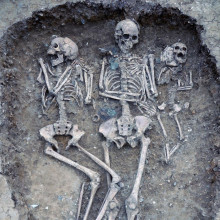
19:12 - DNA secrets from Anglo-Saxon burial site
DNA secrets from Anglo-Saxon burial site
with Dr Richard Durbin, Wellcome Trust Sanger Institute & Richard Mortimer, Oxford Archaeology East.
Recent building works in Oakington, near Cambridge, have uncovered an Anglo 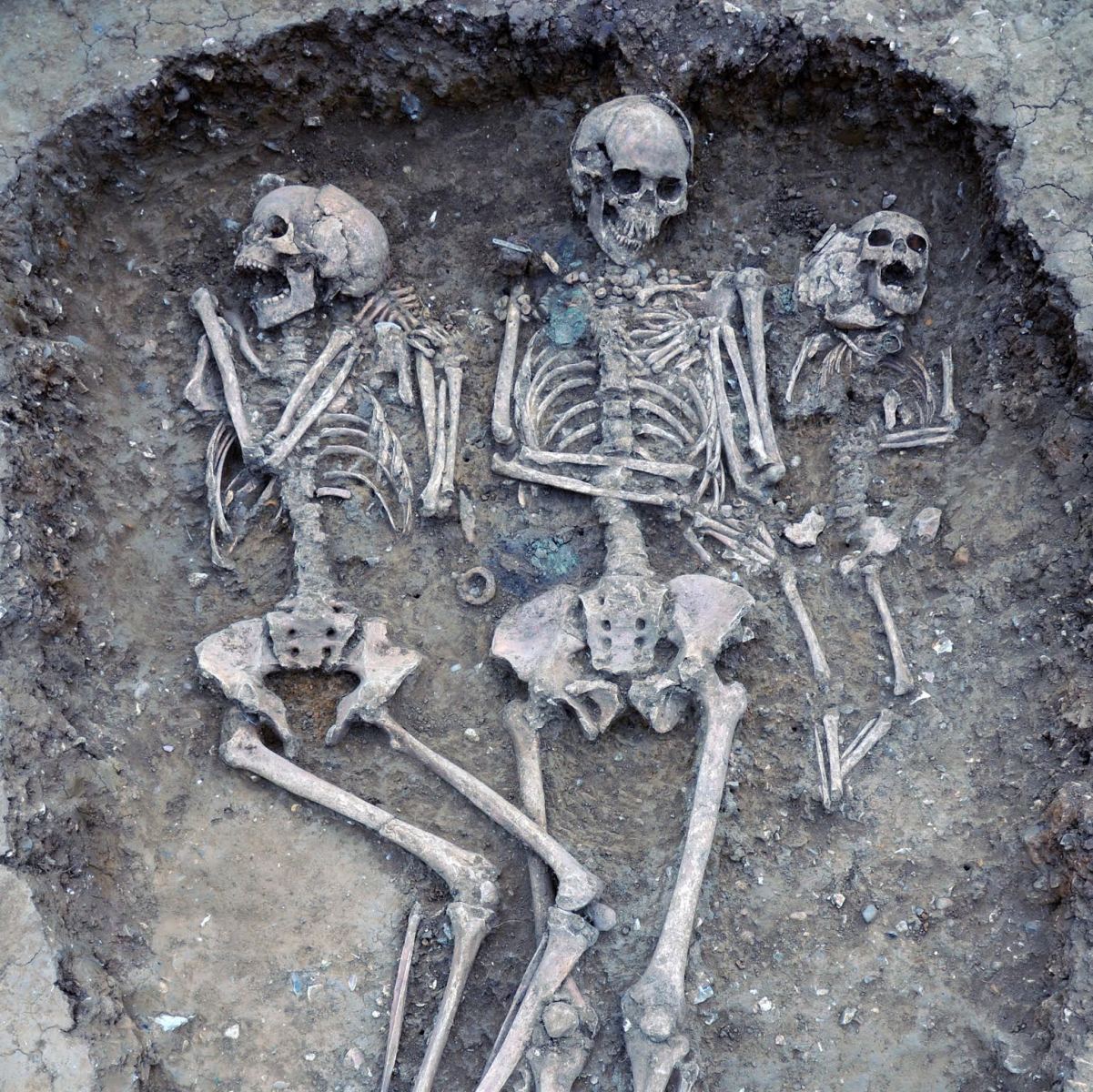 Saxon burial site. With the help of DNA experts in Australia, archaeologists have used the human remains recovered from the site to build an Anglo Saxon genetic profile that they've been able to compare with modern Britons. This is revealing how these European immigrants - a thousand years ago - mixed with the general population. Graihagh Jackson went to meet archaeologist Richard Mortimer at the Museum of Archaeology and Anthropology to see what the research has been turning up...
Saxon burial site. With the help of DNA experts in Australia, archaeologists have used the human remains recovered from the site to build an Anglo Saxon genetic profile that they've been able to compare with modern Britons. This is revealing how these European immigrants - a thousand years ago - mixed with the general population. Graihagh Jackson went to meet archaeologist Richard Mortimer at the Museum of Archaeology and Anthropology to see what the research has been turning up...
Richard - The Anglo Saxons are the formation of England as we now know it. Because by the end of the early Anglo Saxon period, by about 700 AD, England has become physically what it looks like today in the fact that all of our villages and most of our towns is formed or is forming by about 700.
Graihagh - There's a collection of about 20 objects here. They all look like gold but I'm sure they're probably not. People would have been buried with these things - talk me through, what are these?
Richard - Well they are gold, they're gold gilt. Bronze underneath and then gold gilt on top and they are, quite frankly, one of the most beautiful things you'll ever find, as an archeologist. These on the right, these large ones, they'd be for ladies to wear and they'd be to hold, with a pin, hold your dress together.
Graihagh - They're brooches then? They actually are massive. Some of them are bigger than my hand; they almost look like door knockers, to be honest.
Richard - Yes they do. I can't deny it.
Graihagh - And I can see necklaces and combs. They look like little keys on keyrings but I assume they're not that.
Richard - Yes, they are, they're girdle hangers - formalised key sets. One of the women at Oakington buried, oddly enough with a cow; that's not only unusual, it's a first in Britain, it's a first in Anglo Saxon Europe. Nobody's ever been buried with a cow before. And she, the cow lady, got the keys to every lock, and every latch, and every box in that settlement.
Graihagh - Why on earth would you be buried with a cow?
Richard - Absolutely no idea whatsoever. Because it's a first, you just have try and make up our own reasons, you know. Archaeologists just do it anyway. We're telling stories half the time, not telling truths.
Graihagh - Women buried with cows and made up stories aside, this site is extremely important in our quest to understand our British heritage. Over a hundred people were buried at Oakington and they were in good enough condition for scientists, like Dr Richard Durbin, to extract DNA and find out just how Anglo Saxon we really are.
Richard - So what we do is we take a bone, in fact, in our case we took the teeth which are kind of protected by the enamel. We sent those to an expert laboratory in South Australia where they purified, removed all the DNA from the outside so as to get rid of any contaminated material, and then ground it up and isolated a very small amount of DNA and, very sensitively, we brought that back and because it's been degraded, it's in small pieces. So technically this is a hard thing to do but it's become feasible over the last five years or so, and there have been a number of studies but this is the first study of British samples from more than a thousand years ago.
Graihagh - And what, you compared that data with modern humans?
Richard - Yes, what we did is we looked at some of those places where there were clear differences, which were rare and recent, which could tell us a lot about where people came from and then we looked in the ancient samples to see who they shared most with and where they fell in that spectrum of modern variation.
Graihagh - And so, how Anglo Saxon are we?
Richard - Well. It turns out that modern English are about, in the east of England, are about 38%, but if we go further west, Cornwall or to Wales, that fraction drops. So we're all a mixture of the people who were here before, and the people who came in the Dark Ages.
Graihagh - But why is it that modern Welsh are only 30% Anglo Saxon versus east of England being 38% Anglo Saxon?
Richard - I would presume that that is because people coming into the country, you know, predominantly settle in the east, and only progressively moved further afield into the west of England.
Graihagh - So it sort of matches the migration pattern. The Anglo Saxons came over from Europe and landed in the east of England and then migrated west and north, and that's why you see less of this genetic influence on the Scottish, and the Welsh, and people from Cornwall.
Richard - Yes.
Graihagh - It's said quite often, you share, what 50% of your genes with a banana and within species, the human race, it's something like 99.9% or whatever it is. So surely, given that Europeans and these local inhabitants from the Iron Age would have shared a lot of their DNA, what sort of mutations were you looking for to distinguish these populations.
Richard - We're all North West Europeans; we're all genetically quite similar to each other so the differences are subtle. Although we only differ from each other one in a thousand places across three billion bases, that amounts to several million differences. Sometimes new mutations happen, that's what gives rise to differences and ones that happen within a country, within say Denmark, will only be found in the Danes, or in people who mate with them. So we were looking for those, very rare, mutations as traces of identity.
Graihagh - And you say us in the East are 38% Anglo Saxon, often you hear you're 2% Neanderthal! So what's the remaining 60% of us?
Richard - Modern humans left Africa about 50 000 years ago, and that point they met other human species and Neanderthals who had left several hundred thousand years ago, and there was a little bit of intermixing at this point which contributed about 2% we think. And then in Europe there were the hunter gatherer peoples who did the cave paintings that one finds in France and Spain. And then after the ice age the farmers came in and moved across Europe from Turkey, and then there was a later movement of peoples bringing metalworking from Russia. So all of these things have left genetic traces we know other people have been studying. We know people from Britain are a mix of all of those.
Graihagh - An area of further research then?
Richard - I think this is just beginning now, alongside the medical advances we obtained from understanding how the genome works in the body, it will tell us about our history as people and evolution. It's a very exciting time to be a genome scientist.
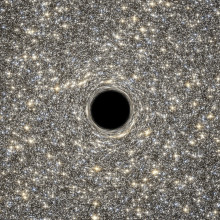
26:24 - What is a black hole?
What is a black hole?
with Matt Middleton, Cambridge University Institute of Astronomy
Black holes are mysterious regions of space with sufficient gravity to bend the  very fabric of space itself - called spacetime - in such a way that nothing, not even light, can escape. Anything unfortunate enough to come into contact with one will be annihilated, becoming part of the black hole itself. But how do these mysterious entities work and how did they form? Georgia Mills met with Cambridge University Institute of Astronomy researcher Matt Middleton for 'Black Holes 101'.
very fabric of space itself - called spacetime - in such a way that nothing, not even light, can escape. Anything unfortunate enough to come into contact with one will be annihilated, becoming part of the black hole itself. But how do these mysterious entities work and how did they form? Georgia Mills met with Cambridge University Institute of Astronomy researcher Matt Middleton for 'Black Holes 101'.
Matt - A black hole in it's simplest possible terms is an object that is incredibly dense, and the speed that it takes to get away from an object is related to how dense it is. The more dense it is, the faster you've got to go and there's a point to which it so dense that not even light can get away from its surface.
Georgia - Like being the fastest thing in the universe.
Matt - Yes, absolutely, In terms of a more rigorous understanding you can imagine there's, for instance, those games you used to play in McDonald's where you throw the coin around and it has that funnel shape. If you can imagine being that coin and trying to get out of that machine, not only are you doing charity a massive disservice, but it's also very, very difficult, and you can imagine trying to go at the speed of light and still not being able to climb out of that thing, that's kind of like what a black hole is. It's this pit that when you go beyond a certain point you can no longer escape.
Georgia - This point of no return is known as 'the event horizon'. We can't see inside because any light that made it there won't escape. But somewhere inside this is what's known as 'the singularity'. This is where all the mass of the black hole is contained in a miniscule area, and to fit all of this mass in such a tiny space, the singularity has to be practically infinitely dense, which pushes our understanding of physics to its limits... So how are black holes created?
Matt - Stars are in constant constant battle against themselves. They're producing lots of radiation; that radiation provides and outward push against the inward pull of gravity, and eventually stars sadly run out of fuel and then gravity's going to win. It collapses in on itself; as it collapses in, material gets thrown away in what we call a supernova explosion. These are really, really big, powerful events.
Georgia - Most stars collapse down to smaller, stable sizes but, if they were big enough, the gravitational forces involved are so strong that nothing can stabilise them and they can collapse down and down and become a black hole. These black holes can grow bigger over time, sucking in anything that strays close enough - from planets to stars and even, potentially, other black holes. What about when you get close to the event horizon; this is when things start to get a little weird. I'll give you an example, here's an alarm clock - lets push it towards the black hole. The ticking gets slower, and slower, and slower, so what's going on?
Matt - I don't know what it takes for you to hate a clock enough to throw it into a black hole...
Georgia - I don't like getting up in the morning...
Mat - You really, really don't - we've all been there haven't we? Okay, so, the clock, if it's ticking, it's going to get slower, and slower, and slower because it's approaching the black hole; it's on increasingly curved space-time and there's this thing called 'gravitational time dilation'. And what we know and what we observe is that clocks run slower closer to massive objects. So for the clock, nothing's happening, it's just ticking at a normal happy rate but, for us, it seems to be ticking slower, and slower, and slower, until eventually, it will appear to be stop ticking at all - that's essentially when it's at the event horizon.
Georgia - Well, now my clock's been destroyed I want it back; I'm going to throw myself into the black hole. From my point of view, what would happen to me?
Matt - Right. Okay, some seriously bad things are going to happen to you. So, there are these things called 'tidal forces'. We know tidal forces, they affect the moon-earth systems, tides, etc. It's why, if you're falling toward a body your feet would feel a greater pull initially than your head so you'd be stretched out. If you take that to the next level, in a black hole you get thinner, and thinner, and thinner and you become 'spaghettified' which is a - oh it's a nasty word. You start to do some crazy things like if you looked to your right or left, you might be able to see the back of your head due to photons travelling around a black hole caught in an orbit, so it would probably be quite a crazy trip. And eventually, of course sadly, you'd be pulled inexorably towards the singularity where your mass would be collapsed down to infinity and you'd contribute to the mass of the black hole.
Georgia - Okay, I've been putting you through your paces with these questions. I'm going to send you some quick-fire questions now because we get a lot sent in from the audience. Everyone's very curious about them. So, first one - can black holes move around?
Matt - Oh absolutely, absolutely. I mean, in orbits they don't just sort of jiggle around or anything. All you really think about is as an object right, with a mass, so absolutely, that mass can interact with other masses and be perturbed and move around all over the place - sure.
Georgia - How common are they compared to other stellar objects?
Matt - Oh rare. I think the upper limit for stellar mass black holes in our galaxy is sort of like a 100 million, something like that, but we have billions upon billions upon billions of stars. There's millions, and millions, and millions of them, possibly but you're not going to look out and go - oh look, a black hole...
Georgia - With your binoculars...
Matt - Yes, yes. You not gonna say - oh what's that coming towards us. I can't see it, it's black. Oh no, not another one.
Georgia - Do black holes every die?
Matt - In principle, yes. So there's this thing Hawking radiation. If you imagine that a particle is created on the event horizon and it breaks in half; half of it can go in and half of it can come out. So, if you have these things called 'imaginary particles', you have like electron-positron pairs, some goes out, some comes in, but that thing that's gone out is carrying some energy and, therefore, mass of the black hole itself, and this is what's called 'hawking radiation'. Now eventually, if a black holes sat on it's own for long enough, eventually there will be enough loss from this for it to die, but the rate at which it loses, the rate at which it evaporates is proportional to mass of black hole cubed. So the bigger your black hole, the longer it's going to take and so, yes, eventually they will die but they're going to take sort of the lifetime of the universe to do so.
Georgia - Final question then - will the large hadron collider create black holes?
Matt - No. Slightly more information?
Georgia - Slightly more information...
Matt - Slightly more information, okay. The energy required to make a mini black hole, which is what they're worried about, is 10 to the 19 GeV. The Hadron Collider runs at a few TeV so it can't do it. You're out by about huge orders of magnitude. What was postulated was that if we have multidimensional spacetime you could lower the threshold to make a mini blackhole to a few TeV, and then there was the possibility that the LHC when it hits these protons together could create these mini black holes. But, Hawking Radiation would remove these black holes almost instantly. We're not to be worried.
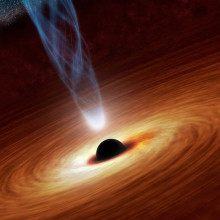
34:25 - Quasars: Black holes and bright lights
Quasars: Black holes and bright lights
with Dr Manda Banerji, Cambridge University Institute of Astronomy
Supermassive black holes, which sit at the centres of galaxies, can have masses ten billion times greater than the Sun,. And despite being black holes capable of locking in light, they've actually been linked to some of the brightest lights in the Universe: quasars. Manda Banerji, who is from the Institute of Astronomy at Cambridge University, tells Chris Smith about these shining lights...
Manda - Quasars, these are the brightest lights that we see in the universe and, basically, what they are are powerful, very energetic emissions but they're coming from the immediate vicinity of these supermassive black holes.
Chris - Are they visible light that I could see with my own eyes, or would I need a fancy telescope to see this sort of light?
Manda - Quasars do emit in visible light, but they also emit in all parts of the electromagnetic spectrum, so all the way from x rays to radio waves.
Chris - And is that the clue that this is not just a star we're dealing with here because the fact that you're seeing all these different ranges of colours of light - all these different wavelengths - and stars don't do that?
Manda - Yes, absolutely. So that is one of the biggest clues; all of this emission and all parts of the electromagnetic spectrum that we're dealing with something very powerful, very energetic.
Chris - And what do you think's going on then to do this?
Manda - So what you need to do to power a quasar is to basically dump a whole load of material, a whole load of matter, onto these supermassive black holes at the centres of galaxies. So, when you have lots of material, lots of gas, dust, stars being funneled into these central regions, all of that material gets heated up and it shines very brightly as a quasar.
Chris - So this is sort of like a black hole with indigestion. It's lots of material trying to pile in very, very fast?
Manda - Yes. It's a feeding monster of a black hole, so quasars are really the feeding phase of a black hole. We're seeing them as they are devouring all the material up around them.
Chris - Do they have any effect on the galaxy on which they sit, by virtue of just existing?
Manda - Yes. So this is one of the main reasons that we study quasars is because we now know that they have a very profound impact on their host galaxies. So we now know that there's a supermassive black hole living at the centres of most galaxies in our universe and when these supermassive black holes feed during this quasar stage, all of this energy that they're outputting into their host galaxy, that can have a very dramatic impact that can blow gas, dust, stars out of the whole galaxy and so in that way it can actually control how big a galaxy will eventually get.
Chris - So it does have an important modelling effect on the ultimate structure of the galaxy. Can you also look at it the other way, which is to say, if I look at the structure of the quasar and its behaviour, can I deduce something about the black hole that is giving rise to it by studying it, and that tell me something about what the black hole is doing itself?
Manda - Yes, absolutely. So, we look at this quasar emission and by looking at the gas and dust that's being eaten up by this black hole, we can infer lots of interesting things about the black hole like, how big it is, how massive it's going to get.
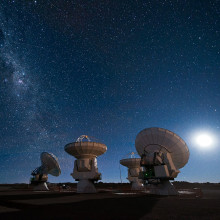
37:45 - The Event Horizon Telescope project
The Event Horizon Telescope project
with Shep Doelman, MIT Haystack Observatory and Harvard Smithsonian Centre for Astrophysics
The event horizon at the mouth of a black hole is the point of no return: once light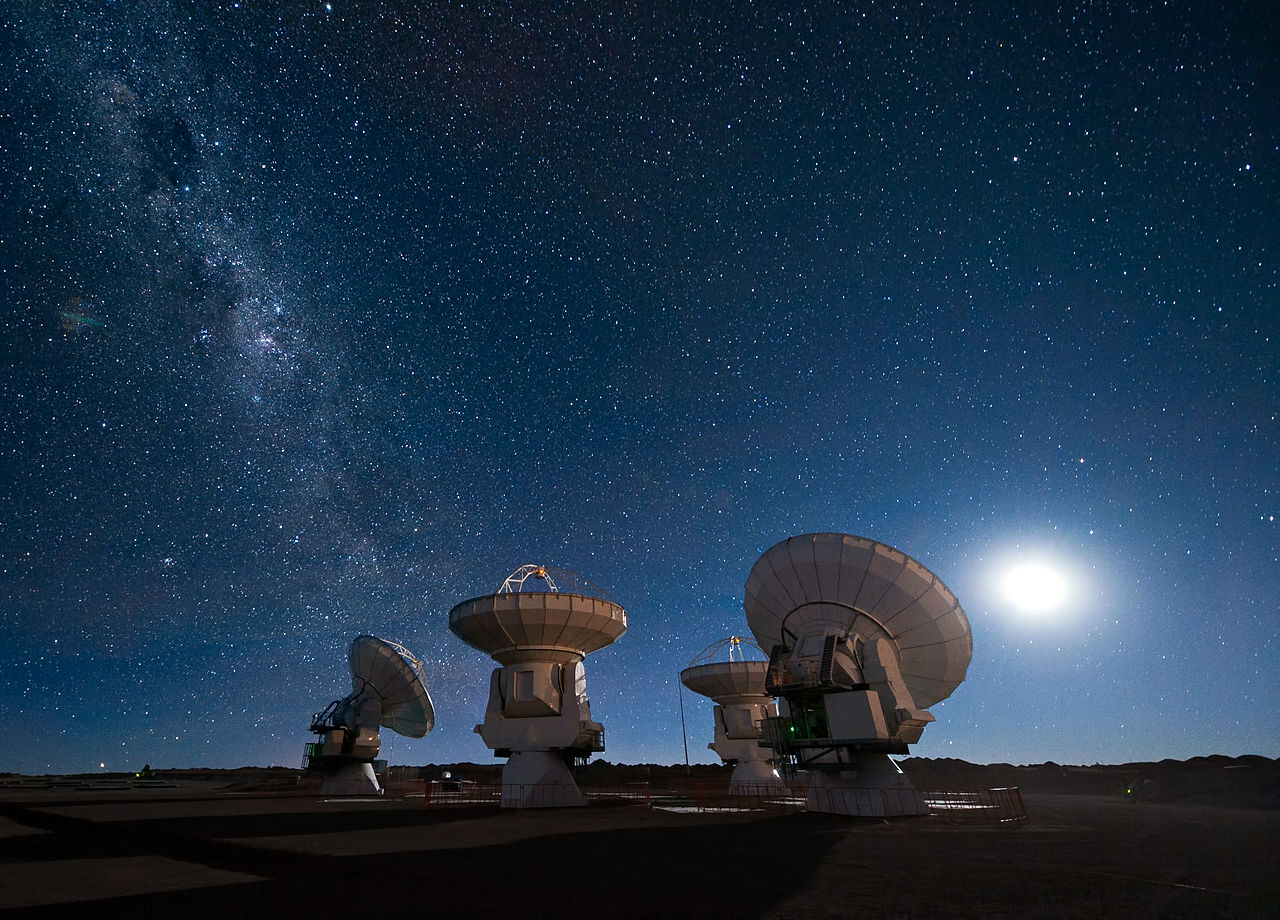 crosses this threshold, there is no going back. This means it's proved impossible for astronomers to physically see what's going on beyond this point. But there might be a way to do it by looking at the shadow cast by the event horizon and using this to infer what made that shadow. Shep Doelman is an astronomer at the MIT Haystack Observatory and Harvard Smithsonian Centre for Astrophysics, and he's part of an initiative called The Event Horizon Telescope project, which aims to get the first image of the shadow cast by the black hole at the centre of our own galaxy, as he explains to Georgia Mills...
crosses this threshold, there is no going back. This means it's proved impossible for astronomers to physically see what's going on beyond this point. But there might be a way to do it by looking at the shadow cast by the event horizon and using this to infer what made that shadow. Shep Doelman is an astronomer at the MIT Haystack Observatory and Harvard Smithsonian Centre for Astrophysics, and he's part of an initiative called The Event Horizon Telescope project, which aims to get the first image of the shadow cast by the black hole at the centre of our own galaxy, as he explains to Georgia Mills...
Shep - There's a part of the Universe that is forever separate from our experience, and that's inside inside the event horizon, and the size and the shape of that event horizon is predicted by Einstein's equations which have withstood all the tests that we've subjected them to in the solar system and the larger universe, and now we'd like to go to the one place where they might break down, at the event horizon itself.
Georgia - Past the event horizon, by its very nature, you can't really see into it. How would you be able to study something like that?
Shep - Well, in a paradox of their own immense gravity, black holes, which by definition are dark are some of the brightest objects in the Universe. You can think of it this way: the black hole is insanely powerful and it's trying to attract all of this gas, dust, and ionised plasma into a very small volume and you get a cosmic traffic jam. Everything is rubbing up against each each and, just as your hands get warm when you rub them together, all this gas and dust heats up to billions of degrees. So it's a little bit like trying to suck an elephant through a straw; it's very hard to do and, when you ultimately do it, it's a big mess. So the black hole and the event horizon are illuminated by this three dimensional flashlight that lights up the space time, and one of the characteristics of the event horizon is that the light gets bent by gravity and so you wind up with a shadow feature. The way you can think about the shadow is that the light that is moving away from you, from the back side of the black hole, gets bent around in these curve trajectories back toward you so it illuminates a ring of light around the event horizon, and it's the size and shape of that ring that we're after with the Event Horizon Telescope Project.
Georgia - So how are you planning to find this shadow?
Shep - Black holes are the smallest objects that we know of and to see something that small you've got to make an entirely new kind of telescope. So we need something, to put it in perspective, that has a magnifying power that's at least 2,000 times better than the Hubble Space Telescope. The best candidate for us to observe one of these black hole shadows is in the centre of our own Milky Way galaxy and radio waves are the perfect medium for that. They can pierce the gas, and the dust, and the ionised plasma that lies between us and the centre of our galaxy. So we need to make a telescope that has 2,000 times the magnifying power of the Hubble that sees radio waves.
Georgia - So the problem here is that you need a radio telescope that's 2,000 times stronger and that, to me, would seem like it would need to be bigger. How are you going to go about this?
Shep - The magic of the Event Horizon Telescope is that we don't make one single telescope, but we use radio dishes that are spread around the globe and we link them together using GPS to synchronise them perfectly, and then we install atomic clocks at each of the sites. And all of the telescopes swivel to look at the black hole at the centre of our galaxy at the same exact moment and, when that happens, you get an earth sized virtual telescope and the radio waves are recorded perfectly at each of the sites. Then hard discs are shipped back on a 747, or the airliner of your choice, to a central facility and when you do that we wind up getting a data set that's equivalent to having a telescope the size of the Earth. And I would hasten to add that when you're making and Earth sized telescope you need and Earth sized group and I'm just pleased as punch to work with some of the most talented astronomers on the face of the Earth from: Taiwan, Japan, Chile, the United States, Europe. It's a really big enterprise.
Georgia - This kind of massive collaboration thing; it seems to me that's what science is all about. How did you get all these different telescopes on board with you?
Shep - Part of the secret sauce of the Event Horizon Telescope is that we're not building any new telescopes. We are developing all the instrumentation that allows us to turn telescopes that already exist into this global linked array. So, what we have done is we've gone to the directors and boards of telescopes around the world; we've explained this project to them and the science payoff is so interesting and exciting to the community that they've allowed us to come in with specialised equipment, install it at the telescopes and make these observations, and we've had some very interesting results so far. We wouldn't really be having this conversation if we hadn't already seen very small shadow sized features towards the black hole at the centre of the galaxy, and now we're going to take those size measurements one step further and see if we can make an actual image.
Georgia - And then at some point in the near future - well when is this going to happen, when are we going to get the telescopes to join up and assemble and all point at the same direction at once?
Shep - Well we're on, as they say, an aggressive timeline. We have already made these precursor observations which show us that we're on the right track and we are, over the next year, finishing the build out across the entire global array. The first possibility for us to really make an image would be in the spring of 2017, that's when of the larger telescopes (The Alma Array, in Chile), will join the Event Horizon Telescope and that will increase our sensitivity by a factor of ten, and also increase our resolution by a factor of two, and that would be the first time when we would have a shot at making a credible image. Knowing that all those 4 millions suns are within that ring would be the strongest evidence that we have, as least as humans (aliens might have better evidence), that black holes actually exist.
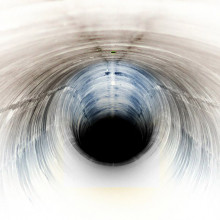
44:45 - Do black holes have "hair"?
Do black holes have "hair"?
with Dr Andrew Pontzen, University College London
Black holes are so far removed from what we can see and test, that they are the  playground of mathematicians and theoretical physicists. This month Stephen Hawking, the king of black hole physics, published a paper stating that black holes have "hairs". This challenges the notion that blackholes destroy everything that enters them completely, leaving a shadow of what might have entered at the event horizon. Andrew Pontzen, a cosmologist from University College London, explains this idea to Kat Arney...
playground of mathematicians and theoretical physicists. This month Stephen Hawking, the king of black hole physics, published a paper stating that black holes have "hairs". This challenges the notion that blackholes destroy everything that enters them completely, leaving a shadow of what might have entered at the event horizon. Andrew Pontzen, a cosmologist from University College London, explains this idea to Kat Arney...
Andrew - I do occasionally wish that some of my physicists colleagues would be better at naming things. This is possibly the least useful name anyone's ever come up with, but the point is supposed to be that if you look at Einstein's theory of general relativity, which is what underlies everything we've been talking about today, about black holes. It makes a very firm prediction that everything about a single black hole, you're looking at a single black hole, it is completely summarised by just three numbers and those three numbers are: it's mass, so how much stuff is in there; it's charge, so if you throw something in that's got static electricity on it it can keep that, and also it's spin, how much it's spinning. And according to general relativity that's all there is to know about a black hole, absolutely nothing else to know about it, and when we talk about hair, what we're saying is, actually maybe there's complications. Every theoretical physicist knows having hair is a real nuisance, it's difficult to make it look any good and so, when we say a black hole has hair we just mean it has extra things that you need to worry about, as well as just those three numbers.
Kat - Okay. So they're not actually like a hairy hole at the middle of the Universe?
Andrew - No, sadly not.
Kat - Okay. Well that's shot down my idea anyway. So how does Stephen Hawking come into this?
Andrew - The whole question was originally posed by Stephen Hawking in a way, because I think earlier on Matt Middleton was mentioning Hawking radiation and that's the one mechanisms we know of by which you can get rid of a black hole. That very slowly a black hole will throw off bits and pieces and then, eventually, it loses all its mass and it actually disappears if you wait a very, very, very long time and that was really one of Stephen Hawking's great discoveries in theoretical physics. But he immediately realised that it poses a kind of strange question, which is that in physics, we normally think that information can't be lost. So, say I chuck something into my black hole so, I mean. I think earlier on Georgia was threatening to throw herself into a black hole so, let's suppose she does that and let's suppose she weighs 60 kg or something - something like that, then the black hole has grown by 60 kg.
Now equally well, we could get it to do that by throwing in sack of potatoes that weighed 60 kg and really then the black hole wouldn't then know any different because, as I was saying earlier on, it's just got these three numbers so all that's happened is it's matters gone up a bit. Then, according the Stephen Hawking's 'Hawking radiation' idea, the black hole disappears and, somehow, all the complexity about Georgia that makes her different from a sack of potatoes, has been completely lost. That sits very uncomfortably with our normal idea that in physics that you can't lose information. If you have a complicated thing sitting there you can't just get rid of all that complexity. So, this poses the question, how can it be that you lose information?
Kat - Sort of what things were, what things were like?
Andrew - Exactly. And where's it gone and so for a long time Stephen Hawking said "well you know, tough, deal with it. The informations lost, it's a new law of physics." But...
Kat - I love physicists...
Andrew - Theoretical physicists...
Kat - We'll just make up another equation just to explain it...
Andrew - Well, you know, when you're stuck you sort of have to. But, he changed his mind. He said "well maybe, looking at the way things are going, looking at new ideas people have about how black holes really work. Maybe somehow or other that information isn't completely lost," and now what he's saying is the information is somehow stored. And it's stored in a very subtle way so that you couldn't really look at a black hole and tell that Georgia had fallen into it but, in a very, very subtle way, on the event horizon itself, it's stored a faint imprint of the fact that it was Georgia and not a sack of potatoes that fell into that black hole.
Kat - And so, presumably, this is the metaphorical hair, the sort of fringe round the edge that has all this information in it.
Andrew - Exactly. You've turned Georgia into hair.
Kat - But if black holes do actually record this, what does this mean for our understanding of black holes, of the Universe, of the theory of physics that we have?
Andrew - If you can make sense of the way that a black hole behaves without losing information, then it really points us towards the next level of understanding black holes and, in particular, what we really want to bring in is what we call a 'quantum theory of gravity.' That's combining Einstein's ideas about warping space and time with the other great development in the 20th century, which was this idea of quantum mechanics. Historically it's been very hard to fit those things together and, perhaps, as we begin to understand these very extreme objects, we'll slowly begin to understand, actually, how should these things fit and together and what does a better theory of physics actually look like.
Kat - And sort of very briefly, obviously, the theoreticians come up with their theories and all of that kind of stuff but, to find out if that is how the universe is working, you need to test it. So, could you explain how could we actually test whether this information is stored?
Andrew - Oh dear, yes, that's pretty hard. I mean there's a reason why theoretical physicists are called 'theoretical physicists.' You know they really try and push the boundaries of theory for, but don't necessarily come up with the tests so, typically, tests are a long way behind. But, if you look at what's happened with black holes, it was thought that the whole idea of black holes was untestable but now we're thinking about things like the Event Horizon Telescope, so maybe one day.

51:15 - Why do humans have such a variety of appearances?
Why do humans have such a variety of appearances?
We put Ghayath's question to population geneticist Sir Walter Bodner from Oxford University...
Walter - You've hardly ever, I imagine - unless you're a pair of identical twins, seen anyone who looks just like you do. We are enormously variable in facial features, and we don't definitely know why that is, but it obviously has strong evolutionary basis; there must be something that's selected for that. I think it's part of the way humans have evolved socially that it's been very important to be able to recognise people who are part of your own group, even your own family. There are very special regions of the brain for identifying faces and there are complex processes by which we analyse and discern what it is in a face that we recognise.
Felicity - How much of that variability is down to genetics?
Walter - Well nearly all of it. If you've ever seen identical twins, they've got exactly the same genetic makeup and when you see them the first time, if you're not their parents or anything, they're almost impossible to distinguish from each other and that tells us that the face is very largely genetically determined. You can vary it; you can have blue hair if you want; you can do things to your face if you go to the right sort of surgeon but, by and large, most of the features that we recognise in a face are very much genetically determined.
Felicity - When we look at other animals, we don't pick up on as much variability perhaps in their facial features. Is this something which is unique to humans?
Walter - No I don't think it is, but remember if you go to another country; if you go to Africa or you go to China, you probably don't find it as easy to recognise the facial differences there as you do in your own group. So that's one thing, we don't necessarily know how to recognise that chimps may look very different to each other, so there's undoubtedly a lot of variation there. Of course, if you take domesticated animals like dogs, a lot of variation has been selected for, so I think there is quite a lot of variation out there; most of it we don't quite know how to recognise.









Comments
Add a comment